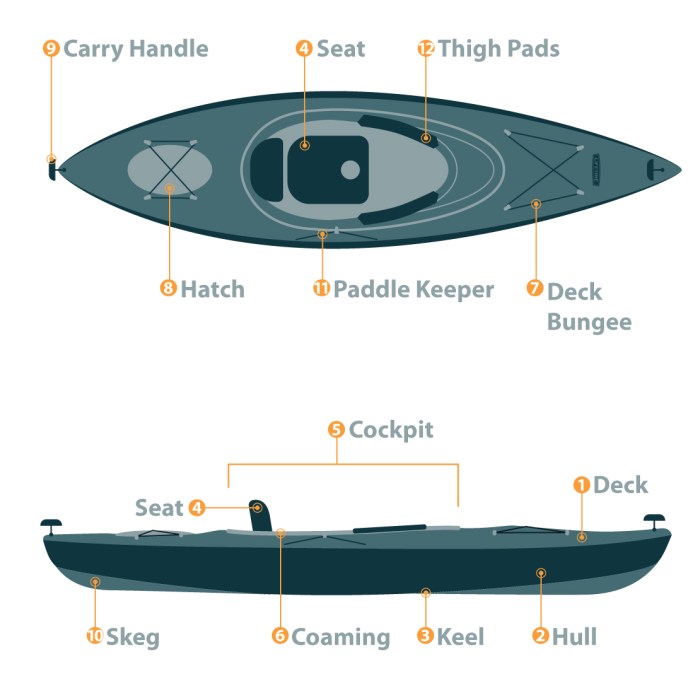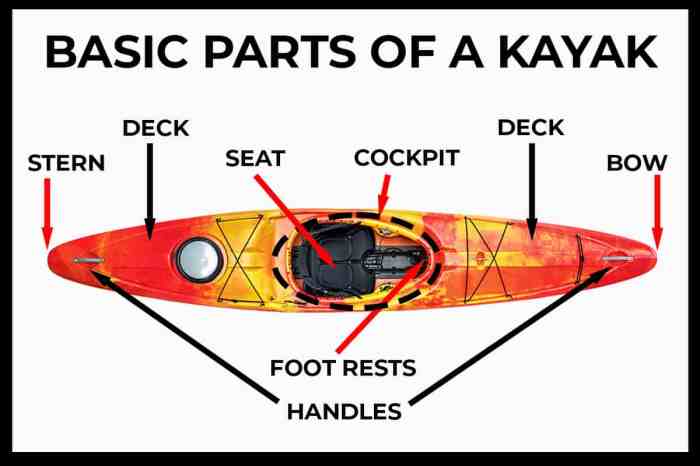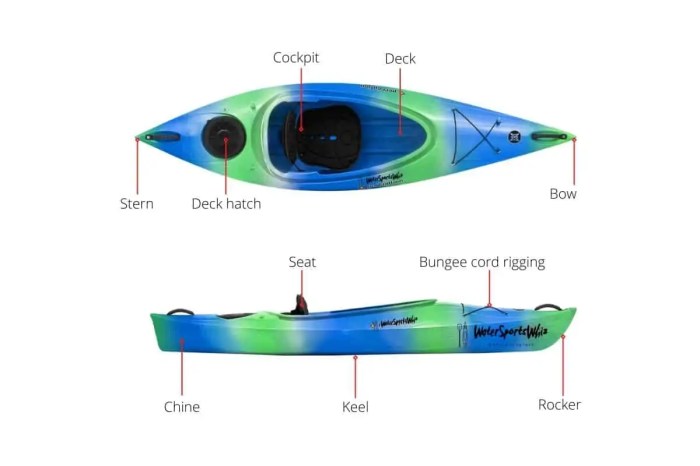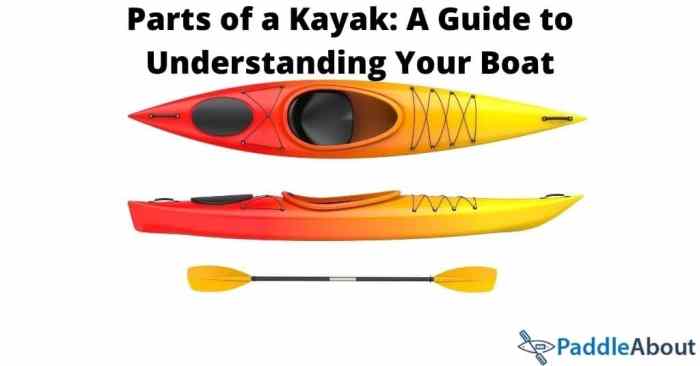Embark on an in-depth exploration of the parts of a kayak diagram, unlocking the secrets of this versatile watercraft. From the sleek hull to the essential accessories, we’ll delve into the anatomy of your kayak, providing insights that will enhance your paddling experience.
Our comprehensive guide unravels the intricacies of each component, empowering you with a thorough understanding of your kayak’s design and functionality.
Hull

The hull is the primary structural component of a kayak, providing buoyancy, stability, and speed. It is typically shaped like a long, slender vessel with a pointed bow and stern, designed to glide efficiently through the water.
Materials Used in Kayak Hull Construction
Kayak hulls are constructed from a variety of materials, each with its own advantages and disadvantages:
- Polyethylene:Durable and impact-resistant, making it ideal for recreational and whitewater kayaking.
- Fiberglass:Lightweight and stiff, offering excellent performance but requiring more maintenance than polyethylene.
- Composite:A combination of materials, such as fiberglass and Kevlar, providing a balance of strength, stiffness, and weight.
- Wood:Traditional and aesthetically pleasing, but requires regular maintenance to prevent water damage.
Hull Designs and Advantages
Different hull designs are optimized for specific kayaking activities and conditions:
- Flatwater Hull:Wide and stable, designed for recreational paddling on calm waters.
- Whitewater Hull:Narrow and maneuverable, with a rockered bottom for navigating rapids and obstacles.
- Touring Hull:Long and sleek, with a deep cockpit for extended paddling trips.
- Sit-on-Top Hull:Open and self-bailing, allowing paddlers to sit on top of the kayak rather than inside.
Cockpit

The cockpit is the central part of the kayak where the paddler sits. It is designed to provide comfort, support, and control. The dimensions of the cockpit vary depending on the size and type of kayak, but it should be large enough to allow the paddler to move freely while paddling.The
cockpit is equipped with a variety of features to enhance the paddler’s experience. These features include:
- Seat:The seat provides support and comfort for the paddler. It is typically made of foam or plastic and can be adjusted to fit the paddler’s body.
- Footrests:Footrests provide support for the paddler’s feet and help to transfer power from the legs to the paddle. They are typically adjustable to fit the paddler’s height and leg length.
- Thigh braces:Thigh braces provide support for the paddler’s thighs and help to keep the paddler in place. They are typically made of foam or plastic and can be adjusted to fit the paddler’s body.
A well-fitting cockpit is essential for comfort and performance. It should be large enough to allow the paddler to move freely, but not so large that the paddler feels unstable. The seat, footrests, and thigh braces should be adjusted to fit the paddler’s body, providing support and comfort.
Deck

The deck is the topmost part of the kayak and covers the cockpit. It provides a platform for the paddler to sit and control the kayak. The shape of the deck can vary depending on the type of kayak and its intended use.
Touring kayaks typically have a long, sleek deck for efficient paddling, while whitewater kayaks have a shorter, more maneuverable deck for navigating rapids.
The deck is typically constructed from a variety of materials, including fiberglass, plastic, and composite materials. Fiberglass decks are lightweight and durable, but they can be more expensive than other materials. Plastic decks are less expensive and more impact-resistant, but they can be heavier than fiberglass decks.
Composite decks combine the strength of fiberglass with the impact resistance of plastic, making them a good choice for kayaks that will be used in rough conditions.
Features
The deck of a kayak typically features a variety of hatches, handles, and bungee cords. Hatches provide access to the kayak’s interior for storage of gear. Handles are used for carrying the kayak and for re-entering the kayak if it capsizes.
If you’re looking to understand the parts of a kayak, a diagram can be a great resource. Diagrams can show you the different parts of the kayak, such as the hull, deck, cockpit, and seat. They can also show you how the different parts of the kayak work together.
For more information, you can also check out pilar hola irene cómo 1 . Diagrams can be especially helpful if you’re new to kayaking or if you’re trying to learn more about how kayaks work.
Bungee cords are used to secure gear to the deck of the kayak.
Rudder and Skeg: Parts Of A Kayak Diagram

Rudders and skegs are essential components of a kayak that help control its direction and stability. Both are mounted at the rear of the kayak, but they serve different purposes and have their own advantages and disadvantages.
Rudders
A rudder is a movable blade that is attached to the stern of the kayak. When the rudder is turned, it creates drag on one side of the kayak, causing it to turn in the opposite direction. Rudders are particularly useful for making precise turns and for correcting for wind or current.
They can also be used to help the kayak track straight, especially in rough water.
There are two main types of rudders: foot-controlled rudders and hand-controlled rudders. Foot-controlled rudders are operated by the kayaker’s feet, while hand-controlled rudders are operated by the kayaker’s hands.
- Advantages of rudders:
- Provide precise control over the kayak’s direction
- Can be used to correct for wind or current
- Help the kayak track straight
- Disadvantages of rudders:
- Can be damaged if they hit obstacles
- Can be difficult to use in shallow water
- Can add weight to the kayak
Skegs
A skeg is a fixed blade that is attached to the bottom of the kayak. Skegs are not as effective as rudders for making precise turns, but they can help the kayak track straight and prevent it from weathercocking (turning into the wind).
There are two main types of skegs: fixed skegs and retractable skegs. Fixed skegs are permanently attached to the kayak, while retractable skegs can be raised or lowered by the kayaker.
- Advantages of skegs:
- Help the kayak track straight
- Prevent the kayak from weathercocking
- Are less likely to be damaged than rudders
- Add little weight to the kayak
- Disadvantages of skegs:
- Not as effective as rudders for making precise turns
- Can be difficult to use in shallow water
Paddle

Kayak paddles come in a variety of shapes and sizes to suit different paddling styles and boat types. The most common type of kayak paddle is the double-bladed paddle, which has a blade on each end of the shaft. Single-bladed paddles are also available, which are typically used for whitewater kayaking.Kayak
paddles are made from a variety of materials, including wood, fiberglass, carbon fiber, and plastic. Wood paddles are the most traditional type of paddle, and they offer a good balance of weight, strength, and durability. Fiberglass paddles are lighter and stiffer than wood paddles, and they are also more resistant to damage.
Carbon fiber paddles are the lightest and stiffest paddles available, but they are also the most expensive. Plastic paddles are the most affordable type of paddle, but they are also the heaviest and least durable.When choosing a kayak paddle, it is important to consider the following factors:*
-*The length of the paddle
The length of the paddle should be appropriate for your height and the type of kayaking you will be doing.
-
-*The width of the blade
The width of the blade will determine how much power you can generate with each stroke.
-*The shape of the blade
The shape of the blade will affect how the paddle moves through the water.
-*The material of the paddle
The material of the paddle will determine its weight, strength, and durability.
By considering these factors, you can choose the right kayak paddle for your needs.
Accessories

Kayaking accessories are essential for enhancing your paddling experience, ensuring safety, and making your adventures more enjoyable. Having the right gear can significantly improve your comfort, performance, and overall enjoyment on the water.
Here’s a list of essential kayak accessories to consider:
PFD (Personal Flotation Device)
- A PFD is a life-saving device that keeps you afloat in case of an emergency.
- Choose a PFD that fits snugly and is appropriate for your weight and water conditions.
Bilge Pump, Parts of a kayak diagram
- A bilge pump removes excess water from your kayak, keeping it dry and stable.
- Consider getting a manual or electric pump for efficient water removal.
Paddle Float
- A paddle float prevents your paddle from sinking if you drop it overboard.
- It’s a simple but essential accessory that ensures you don’t lose your paddle.
Dry Bag
- A dry bag protects your valuables from water and moisture.
- Keep your phone, keys, wallet, and other essentials safe and dry.
Spray Skirt
- A spray skirt keeps water out of your kayak while paddling in rough conditions.
- It also helps improve stability and warmth by reducing wind chill.
Safety Whistle
- A safety whistle is a vital tool for signaling for help in an emergency.
- It’s a simple but effective way to attract attention if you need assistance.
First-Aid Kit
- A first-aid kit is essential for treating minor injuries or emergencies on the water.
- Include basic bandages, antiseptic, pain relievers, and any necessary medications.
Frequently Asked Questions
What is the most important part of a kayak?
The hull, as it provides buoyancy and stability.
What is the difference between a rudder and a skeg?
A rudder is a movable blade that helps steer the kayak, while a skeg is a fixed blade that provides directional stability.
What are the different types of kayak paddles?
Single-bladed, double-bladed, and Greenland paddles, each with its own advantages and disadvantages.